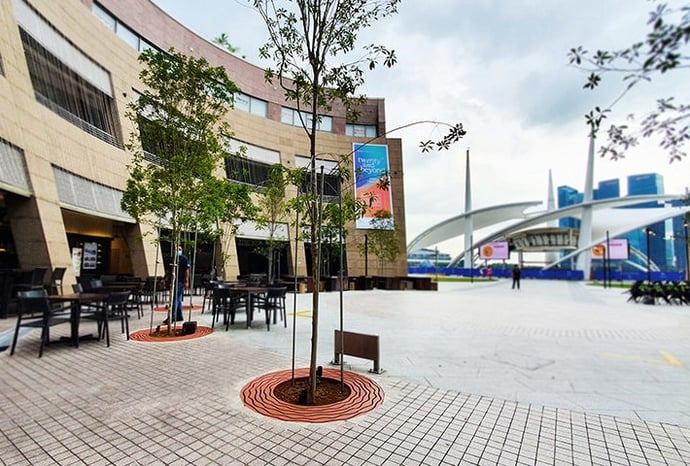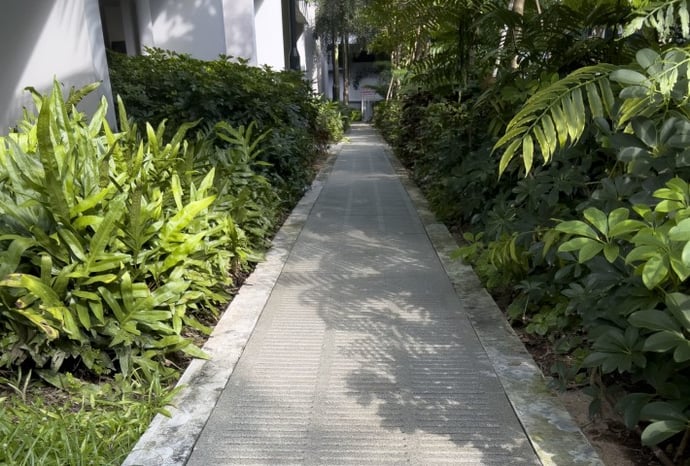Urban streetscapes and shared spaces can be difficult to plan. When planned improperly, they can become unpopular, unmanageable, or even fall into disrepair. This negatively impacts their place in the community and the community’s opinion of the space.
With proper planning, streetscapes and shared spaces can elevate an area. They beautify the surroundings, add culture, and give locals and visitors somewhere to go and something to do. An effective space makes a community better.
However, in order to get these benefits, knowing a few key details is important. Being aware of what to watch out for can make the planning process easier and more effective.
Aesthetic Design Considerations
Urban design needs to consider the practical and aesthetic aspects of the area. Oftentimes, the visuals are what is first noticed. There are a few principles usually taken into account when planning the visual aspects of outdoor spaces.
Sense of Enclosure
A common convention in urban design is that public spaces require a distinct physical form that distinguishes the space as a clear place. Often, this is created through a sense of enclosure, stemming from buildings and the landscape in the area. These features visually hold the eye to form a distinct space while also opening up and allowing the creation of the space itself.
Traditionally, urban designers use set ratios between the height and width of these buildings, trees, or other features. However, some architects purport that you don’t need to follow this ratio theory fully. Many striking areas do not follow this convention, including St. Peter’s Square in the Vatican and the streets of The Shambles in York, England.
When planning a streetscape or shared space, creating contrast in the design can be an alternative way to form a sense of place while opening up space for creativity. Some ways to incorporate contrast include:
- Horizontal and vertical features
- Use of color
- Additions of walls vs. door, window vs. door, etc.
- Light patterns formed by trees and other features
Harmony With Surroundings
Another aesthetic consideration is how the space both harmonizes and stands out with regard to its surroundings. Though these two factors are somewhat contradictory, considering both of them is important.
First, consider harmony. Everyone is aware that a space should not clash with its surroundings. Instead, the space should fit in and complement the spaces around it.
To do this, it is important to properly examine and contemplate these surroundings. If the space is in the middle of tall, sleek office buildings, a contemporary and modern vibe will work well. If there are any artistic motifs in the surrounding buildings, these can be incorporated into the space as well.
 Shared spaces should blend with their surroundings while having enough of an identity to hold their own.
Shared spaces should blend with their surroundings while having enough of an identity to hold their own.
However, in some cases, having the space establish its own identity may also be helpful. This is how the space stands out.
For example, a park in the middle of an urban setting can be an oasis of green. Some spaces may even choose to differentiate their style from their surroundings in order to be a quirky and unique addition to the location.
Balancing harmony with individuality is not a straightforward process. Each space is different and, thus, will strive for a different level of harmony. Because of this, it is necessary to consider the aesthetic goals of the location before beginning.
Practical Considerations
A shared space or streetscape should also adequately meet its intended purpose. The area should be comfortable and easy to use. In addition, it should be clear what the area is used for and inviting towards that purpose.
Cater to the public
When creating a shared space, it’s important to start by determining who will use the area and how. Different groups will have different needs that will impact how the area will be used. These uses should guide the designing and planning process.
For example, an area packed with office buildings and commercial spaces might not be the best place to put a child-focused playground. Instead, a calm garden serves as a location for stressed office workers to unwind.
Meanwhile, the same space may be less suitable for an area packed with family apartments. In an area like this, a playground or family-fun area will be a better choice.
In any situation, these considerations have to be made. This will ensure that the space is suitable for the people who will actually be using the space. Otherwise, the space will not be as efficiently used as it could be.
Evolution of Public Spaces
Public spaces are often planned with a certain use and feeling in mind. However, over time, the space may come to be used for things other than its intended use. Because of this, it’s important to keep the possibility of change in mind.
Public Safety
Safety is always a concern, especially in public spaces. Keeping an area safe will make the people in it feel happy and comfortable, leading to higher levels of use.
There are plenty of different options to keep an area safe. Some are more advanced and elaborate. However, simple solutions are also available.
One advanced solution is to install a station to call for help. These usually just require one to push a button in order to alert the police that someone needs help. However, when it comes to advanced solutions, advancements are constantly being made. So, it is important to look into what is currently available.
Sometimes, simple changes to an area can have a big impact on public safety. Adding lights and keeping the area bright may seem like a small change but does a lot to deter crime. Even ensuring that the area is handicap accessible and is free from trip and fall hazards prevents accidents from occurring.
Enhance Usability
Urban spaces are meant to be used and enjoyed by the public. In order to enhance usability and encourage use, architects should consider how their design helps make the space more comfortable and enjoyable to use.
Climate Management
Streetscapes and public spaces benefit massively when they are kept in a comfortable climate. Urban street trees are a great way to do this. Tree-lined streets maintain lower ambient temperatures, encouraging foot traffic. This, in turn, can encourage increased economic activity.
It is vital to adequately protect street trees as they are an investment for the area. Commonly, this is done by either using tree pits or tree grates. While tree pits provide ample space for the trees’ roots to grow and expand, they do little to actually protect the tree roots from passerbys.
 Tree grates protect tree roots from damage but can also add visual interest.
Tree grates protect tree roots from damage but can also add visual interest.
On the other hand, installing tree grates can meet this goal of protection. Jonite reinforced stone tree grates protect the trees’ roots from traffic. However, they still allow air and water to permeate the soil and reach the roots.
Drainage Management
A key factor in keeping an area usable is ensuring that excess water from rain events is quickly drained away. Pedestrian areas can quickly become unusable and even hazardous to the public otherwise.
Trench drains and grates should be installed in key areas to keep walkways and other areas dry and safe. Planners can even create a system that collects all excess water from the area and moves it to a drainage point.
When choosing trench drain grates, it’s important to choose a drain grate supplier that provides beautiful, durable, and easy-to-maintain grating options. Jonite’s reinforced trench grates can hold up to daily traffic, including options that can withstand vehicle traffic.
Maintenance
Urban shared spaces should incorporate elements that are easy to maintain. This helps keep the space usable in the time between routine maintenance. However, it can also save the municipality time and money.
When choosing installations, such as trench grates, it’s important to pay attention to the material used. Oftentimes, this is one of the biggest factors in how easy or difficult the item will be to maintain. Plastic installations are low-cost but prone to breaking when put under stress. Metal, such as iron, is strong but may face corrosion and heat problems.
On the other hand, reinforced stone is a strong, material that can be used for gratings, ventilation, and other installations.
Site Furniture
Furniture used in shared spaces serves a critical, yet sometimes overlooked function. Adding furniture can help guide people to the intended use of the space. It can even affect how a shared space is perceived.
Incorporating welcoming furniture helps the public feel that they can openly use the space and furniture, increasing the chances that people will actually use the area. Outdoor tables and seating can provide flexibility in seating and use. In fact, this has become a common addition to shared space. Furnishing can even increase the use of urban streetscapes. By adding benches, tables, trashcans, and even bike walks, you can design a space that pedestrians will use.
It’s also important to choose options that will be able to stand up to the outdoor environment. For example, commercial-grade furnishings are strong enough to stand up to daily use. Powder-coated steel is durable in any weather but can be easily wiped clean after each use.
Common Obstacles
Urban planners face unique obstacles stemming from the location of their projects. These streetscapes and spaces are usually in areas where the topography, existing structures, and proximity to locals.
Topography
One of the most common obstacles for urban designers is steep topography or changes in terrain. When this is a problem, fewer materials will keep the surface optically smooth instead of using contrast. In these cases, try to stick with neutral materials with the same textures and patterns. This will help streamline the area to be used for foot traffic.
Existing Establishments
Many urban planners need to work within the confines of existing establishments. This could include other buildings, roads, or greenery. Architects must maintain adequate access to businesses and retail buildings in particular.
Some urban areas have historical or symbolic characteristics to the local area. When this is the case, the new design should preserve these characteristics whenever possible. Maintaining the soul of the area provides originality and can even appeal emotionally to visitors.
In addition, utilizing existing plants can provide benefits. Maintaining existing plants is generally easier than establishing new ones, however, it adds to the challenge of planning.
Communication
During the planning and development phases, it is critical to maintain communication. Construction tends to have a negative impact on both locals and visitors. However, you can strengthen public confidence in the project through open communication and limiting inconveniences.
Environmental Impact
While not required, urban designers have increasingly considered their designs' environmental impact. In fact, planners often not only try to minimize the negative impacts but actually create designs that benefit the environment.
 Choosing low-impact materials is one way to reduce the negative impact of man-made spaces.
Choosing low-impact materials is one way to reduce the negative impact of man-made spaces.
By using regenerative design principles, you can increase the resilience and biodiversity of the area while also reducing maintenance and construction costs. When planning streetscapes and shared spaces, this often means focusing on avoiding drastic temperature shifts in the area. Windbreaks and the use of low-impact materials can help with this. Reinforced stone grates and drains are an easy choice when it comes to this.
Create Functional and Original Urban Spaces
Shared urban spaces and streetscapes are an ideal way to provide the public with unique areas to spend their leisure time. When planning these spaces, urban architects need to account for the practical use of the area while developing an aesthetically pleasing design. One step is working with a drain grate supplier to choose beautiful, functional gratings.
Contact Jonite to add high-quality gratings to your next urban design.










